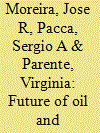|
|
|
Sort Order |
|
|
|
Items / Page
|
|
|
|
|
|
|
| Srl | Item |
| 1 |
ID:
127161


|
|
|
|
|
| Publication |
2014.
|
| Summary/Abstract |
This work compares the return on investments (ROI) of oil versus biofuels in Brazil. Although several renewable energy sources might displace oil, the country's forte is sugarcane biofuels. In our analysis we carry out simplified benefit-cost analyses of producing oil fields, pre-salt oil fields (without and with enhanced oil recovery), a business as the usual ethanol scenario, and a high ethanol scenario. Excluding the ROI from existing oil fields, which is the highest, when the discount rate is 4% or more, the ROI of the high ethanol scenario is greater than that of the ROI of pre-salt oil. Considering a US$40/t CO2 tax, the high ethanol scenario's ROI is greater than the pre-salt oil's ROI if a discount rate of 2% or more is adopted. Moreover, the high ethanol scenario throughput up to 2070 compares to 97% of the pre-salt oil reserve without EOR, and demands 78% of its investment. Pre-salt oil production declines beyond 2042 when the country might become a net oil importer. In contrast, ethanol production reaches 2.1 million boe per day, and another 0.9 million boe of fossil demand is displaced through bioelectricity, yielding a total of 3 million boe (62% of the country's oil demand).
|
|
|
|
|
|
|
|
|
|
|
|
|
|
|
|
| 2 |
ID:
092819


|
|
|
|
|
| Publication |
2009.
|
| Summary/Abstract |
This work models the carbon neutralization capacity of Brazil's ethanol program since 1975. In addition to biofuel, we also assessed the mitigation potential of other energy products, such as, bioelectricity, and CO2 emissions captured during fermentation of sugar cane's juice. Finally, we projected the neutralization capacity of sugar cane's bio-energy system over the next 32 years. The balance between several carbon stocks and flows was considered in the model, including the effects of land-use change. Our results show that the neutralization of the carbon released due to land-use change was attained only in 1992, and the maximum mitigation potential of the sugar cane sector was 128 tonnes of CO2 per ha in 2006. An ideal reconstitution of the deployment of the sugar cane sector, including the full exploitation of bio-electricity's potential, plus the capture of CO2 released during fermentation, shows that the neutralization of land-use change emissions would have been achieved in 1988, and its mitigation potential would have been 390 tCO2/ha. Finally, forecasts of the sector up to 2039 shows that the mitigation potential in 2039 corresponds to 836 tCO2/ha, which corresponds to 5.51 kg of CO2 per liter of ethanol produced, or 55% above the negative emission level.
|
|
|
|
|
|
|
|
|
|
|
|
|
|
|
|
|
|
|
|
|